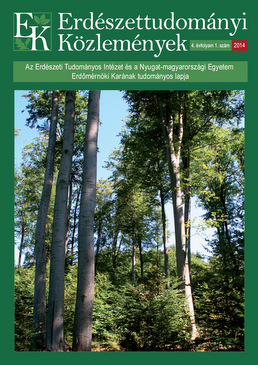| 1. | Állami Erdészeti Szolgálat (ÁESz): Országos Erdőállomány Adattár 2007. |
| 2. | Bartha D. és Puskás L. 2013: Silva naturalis Vol.1. Nyugat-magyarországi Egyetem Kiadó, Sopron. |
| 3. | Brokaw, N. and Busing, R.T. 2000: Niche versus chance and tree diversity in forest gaps. Trends in Ecology and Evolution, 15: 183-188. DOI: 10.1016/s0169-5347(00)01822-x |
| 4. | Brown, N.D. 1993: The implications of climate and gap microclimate for seedling growth conditions in a Bornean lowland rain forest. Journal of Tropical Ecology, 9: 153-168. DOI: 10.1017/s0266467400007136 |
| 5. | Busing, R.T. and Brokaw, N. 2002: Tree species diversity in temperate and tropical forest gaps: the role of lottery recruitment. Folia Geobotanica, 37: 33-43. DOI: 10.1007/bf02803189 |
| 6. | Collins, B.S. and Pickett, S.T.A. 1987: Influence of canopy opening on the environment and herb layer in a northern hardwoods forest. Vegetatio, 70: 3-10. DOI: 10.1007/BF00040752 |
| 7. | Cowell, C.M.; Hoalst-Pullen, N. and Jackson, M.T. 2010: The limited role of canopy gaps in the successional dynamics of a mature mixed Quercus forest remnant. Journal of Vegetation Science 21: 201-212. DOI: 10.1111/j.1654-1103.2009.01137.x |
| 8. | Csépányi P. 2008: A tölgy és folyamatos erdőborítás. Erdészeti Lapok, 143 (10): 294-297. full text |
| 9. | de Lima, R.A.F.; Prado, P.I. Martini, A.M.Z.; Fonseca, L.J.; Gandolfi, S. and Rodrigues, R.R. 2012: Improving methods in gap ecology: revisiting size and shape distributions using a model selection approach. Journal of Vegetation Science, 24 (3): 484-495. DOI: 10.1111/j.1654-1103.2012.01483.x |
| 10. | Diaci, J. (ed.) 2006: Nature-based forestry in Central Europe. Alternatives to industrial forestry and strict preservation. University of Ljubljana, Biotechnical Faculty, Department of Forestry and Renewable Forest Resources, Ljubljana. |
| 11. | Dövényi Z. (szerk.) 2010: Magyarország kistájainak katasztere. Magyar Tudományos Akadémia, Budapest. |
| 12. | Eysenrode, D.S.V.; Bogaert, P.; Van Hecke, P. and Impens I. 1998: Influence of tree-fall orientation on canopy gap shape in an Ecuadorian rain forest. Journal of Tropical Ecology, 14 (6): 865-869. DOI: 10.1017/s0266467498000625 |
| 13. | Gálhidy L. 2008: Az aljnövényzet fajösszetételének és tömegességének változásai középhegységi bükkösök mesterséges és széldöntés nyomán létrejövő lékjeiben. Doktori értekezés. ELTE, Növényrendszertani és Ökológiai Tanszék, Budapest. |
| 14. | Hammer, Ř.; Harper, D.A.T. and P. D. Ryan 2001: PAST: Paleontological Statistics Software Package for Education and Data Analysis. Palaeontologia Electronica, 4(1), 9 pp. |
| 15. | Hunter, J.C. and Barbour, M.G. 2001: Through-growth by Pseudotsuga menziesii: a mechanism for change in forest composition without canopy gaps. Journal of Vegetation Science, 12: 445-452. DOI: 10.2307/3236996 |
| 16. | Kenderes K. 2008: Kelet-közép európai bükkösök természetes dinamikája. Doktori értekezés. ELTE TTK, Növényrendszertani és Ökológiai Tanszék, Biológia Doktori Iskola, Budapest. |
| 17. | Kenderes K.; Tímár G.; Ódor P.; Bartha D.; Standovár T.; Bodonczi L.; Bölöni J.; Szmorad F. és Aszalós R. 2007: A természetvédelem hatása középhegységi erdeinkre. Természetvédelmi Közlemények, 13: 69-80. |
| 18. | Kenderes, K.; Mihók, B. and Standovár, T. 2008: Thirty years of gap dynamics in a central european beech forest reserve. Forestry, 81 (1): 111-123. DOI: 10.1093/forestry/cpn001 |
| 19. | Király G. 2008: Soproni-hegység. 224. In: Király G.; Molnár Zs.; Bölöni J.; Csiky J. és Vojtkó A. (szerk.): Magyarország földrajzi kistájainak növényzete. MTA-ÖBKI, Vácrátót. |
| 20. | Kiss M. 2014: Átlagos középhőmérséklet-, csapadékösszeg-, napfénytartalom- és párolgás adatok 2009-2012. Országos Meteorológiai Szolgálat, Soproni Meteorológiai Állomás. |
| 21. | Márkus L. és Mátyás V 1966: A bükkmakk termésbiológiájának ismeretéhez. Erdészeti Kutatások, 62: 177-193. |
| 22. | MathWorks 2008: MATLAB. version R2008A. MathWorks, Natick, Massachusetts, USA. |
| 23. | Mátyás V. 1965: Ökológiai megjegyzések a tölgy és a bükk termésének időszakosságához. Erdészeti Kutatások, 61: 99-121. |
| 24. | McCarthy, J. 2001: Gap dynamics of forest trees: A review with particular attention to boreal forests. Environmental Reviews, 9: 1-59. DOI: 10.1139/er-9-1-1 |
| 25. | Mendlik G. 1989: A bükkösök természetes felújításának újabb irányai. Erdészeti Kutatások, 80-81: 284-288. |
| 26. | Mihók B. 2007: Lékek fénymintázata és növényzeti regenerációja bükkös állományokban. Doktori értekezés. ELTE TTK, Növényrendszertani és Ökológiai Tanszék, Biológia Doktori Iskola, Budapest. |
| 27. | Mollay J.-né és Molnár Á. 2011: A Sopron-hegyvidéki erdők állományainak változása 1955-2005 között. 122-239. In: Bartha D. és Oroszi S. (szerk.): A Soproni-hegység erdőállományainak története. TAEG Tanulmányi Erdőgazdaság, Sopron. |
| 28. | Pommerening, A. and Murphy, S.T. 2004: A review of the history, definitions and methods of continuous cover forestry with special attention to afforestation and restocking. Forestry, 77: 27-44. DOI: 10.1093/forestry/77.1.27 |
| 29. | Solymos R. 2008: Folyamatos erdőborítás – természetes felújítás – szálalóerdő. Erdészeti és Faipari Híradó, 18: 6-7. |
| 30. | Solymos R. 2011: Természetes erdőfelújítás – folyamatos erdőborítás. Erdészeti Lapok, 151: 72-74. full text |
| 31. | Standovár T. 2006: Biológiai megfontolások az erdei életközösségek hatékony védelméhez. Magyar Tudomány, 2006/6: 656-662. |
| 32. | Standovár, T. and Kenderes, K. 2003: A review on natural stand dynamics in beechwoods of East Central Europe. Applied Ecology and Environmental Research, 1: 19-46. DOI: 10.15666/aeer/01019046 |
| 33. | Tamás J. 2011: A Sopron hegyvidéki erdők történelmi fejlődése, tájleírásai a fafaj, elegyarány és korosztály viszonylatában napjainkig (1955). 5-121. In: Bartha D. és Oroszi S. (szerk.): A Soproni-hegység erdőállományainak története. TAEG Tanulmányi Erdőgazdaság, Sopron. |
| 34. | Tobisch T. 2009: Egyenletes bontáson és lékvágáson alapuló erdőfelújítás összehasonlítása gyertyános-kocsánytalan tölgyesben. Doktori értekezés. Nyugat-magyarországi Egyetem Erdőmérnöki Kar, Roth Gyula Erdészeti es Vadgazdálkodási Tudományok Doktori Iskola, Sopron. full text |
| 35. | Tobisch, T. and Standovár, T. 2005: A comparison of vegetation patterns in the tree and herb layers of a hardwood forest. Community Ecology, 6 (1): 29-37. DOI: 10.1556/comec.6.2005.1.4 |
| 36. | Török A. 2000: Égtájorientált, erdőtípus-érzékeny természetes felújítási rendszer. Erdészeti Lapok, 135: 170-171. full text |
